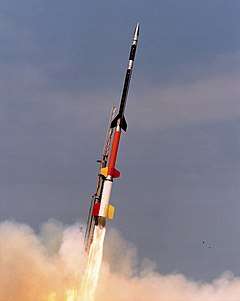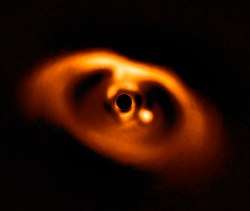SISTINE
SISTINE (also known as SISTINE Mission and SISTINE Program) (acronym for "Suborbital Imaging Spectrograph for Transition region Irradiance from Nearby Exoplanet host stars") is a NASA mission designed to study distant stars as a way of finding life on exoplanets.[1][2]

The technology to be employed is up to 100 times the UV spectroscopic ability of the Hubble Space Telescope.[3] The first test of the mission will be launched on a Black Brant 9 rocket, a two-stage sounding rocket, at White Sands Missile Range, New Mexico, on 5 August 2019.[4] This suborbital rocket can carry a payload of up to 1200 pounds, which, in the case of SISTINE, includes spectrographic equipment capable of covering the far ultra-violet spectral range of 100 to 160 nm, well suited to study strong atomic emission lines associated with the formation temperatures in the atmospheres of low-mass stars, and their effects on the potential atmospheres of exoplanets.[4]
After testing and calibration, a second launch will occur in 2021 from the Arnhem Space Centre in Nhulunbuy, Australia.[1] This launch will study the spectra of Alpha Centauri A and B in the Alpha Centauri system which contains three stars and Proxima Centauri b, the closest exoplanet to the Earth.[1]
The prinicpal investigator of the mission is astronomer Kevin France, Assistant Professor at the Department of Astrophysical and Planetary Sciences, Laboratory for Atmospheric and Space Physics, University of Colorado in Boulder, Colorado.[1][5][6]
References
- Hatfield, Miles (2 August 2019). "Shining (Star)light on the Search for Life". NASA. Retrieved 3 August 2019.
- NASA (2 August 2019). "News Release 2-Aug-2019 - Shining (star)light on the search for life". EurekAlert!. Retrieved 3 August 2019.
- France, Kevin; et al. (2016). "The SLICE, CHESS, and SISTINE Ultraviolet Spectrographs: Rocket-borne Instrumentation Supporting Future Astrophysics Missions". Journal of Astronomical Instrumentation. 5 (1): 1640001. arXiv:1512.00881v1. Bibcode:2016JAI.....540001F. doi:10.1142/S2251171716400018.
- Staff (2019). "36.333 UG France/University of Colorado - Suborbital Imaging Spectrograph for Transition region Irradiance from Nearby Exoplanet host stars (SISTINE)". NASA. Retrieved 3 August 2019.
- PBtS (18 December 2017). "428: Dr. Kevin France: Bright Researcher Studying Exoplanets and their Stars and Developing New Astrophysics Technology". PBtS. Retrieved 3 August 2019.
- France, Kevin (209). "Kevin France - profile". University of Colorado. Retrieved 3 August 2019.
